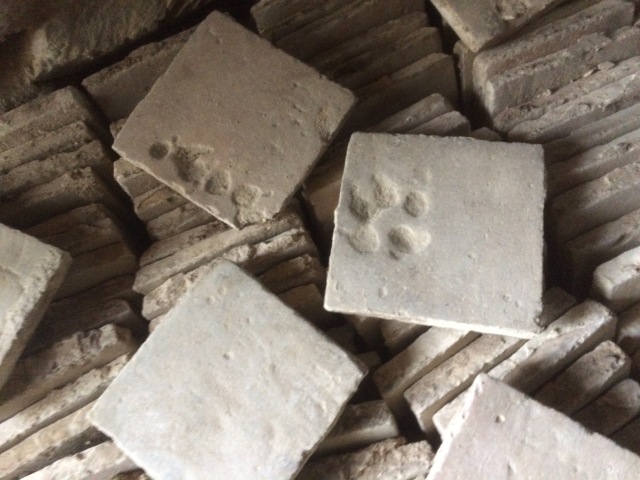The Easter break was a time for visiting friends, afternoons out and starting to get the sap rising on our forever home. Celine was keen to get things moving and spent a good part of two days lifting the tomette floor tiles from the first floor loft with me. I carried them down the ladder, ten at a time, and stacked them in the garage below. In all I went up and down that ladder more than ninety times. The tiles themselves are beautiful ancient handmade things. Their colours vary wonderfully. One day they will be re-laid in the sejour where we can see them every day.

Before we started this particular activity the loft was stacked with materials on top of four inches of celotex solid foam insulation, put down in an effort to keep the sejour warm over Winter. We had no idea what we would find, but amongst the tiles we uncovered one or two that showcased evidence of a rather large hound.

This reminded me of some research I had carried out the year before regarding historical wolf activity in the past. There was a fabled ‘wolf of Bayeux’ which was actually a euphemism for starvation, and would visit the poor through the cold Winter. More frightening is the historical record which shows just why the European wolf was hunted so remorselessly. The last recorded wolf attack local to us was in Pre-en-Pail, some nine kilometres (five miles) East, back on July 24th 1598. Sadly the victim was a child, who died from his wounds. Children were especially vulnerable and many were taken and eaten during this time. It was part of a spate of ten incidents spread over six years, but wolves continued to be a menace into the eighteen-hundreds right across the region, and all of France.

Image courtesy of the University of Caen.
Wolves habitually used track-ways that ran along the bottoms of valleys, close to streams and away, for the most part, from human settlements. Our house is part of a small group perched on a low rise with far reaching views of the forest to the North and West. Below us is a narrow valley, popular with walkers and horse-riders today. Two hundred years ago, taking that route to Les Chapelles or St Aignan would have been a different prospect.

We would have taken a large hound with us, especially during the short dark Winter days. But in the Summer months, when we would have been laying our tomettes out to dry before firing, in the courtyard in front of the kiln, our hound would still have been on guard as the majority of the attacks in the Mayenne occurred June to September. We would have had our children helping with the lifting and carrying. The smaller ones too. There would be no chance of letting them wander off on their own in the Summer sun to seek relief in the shade at the edges of the woods, or cool off down by the trickling stream.

Our hound, we’d call him Roch after the patron saint of dogs, he would bark at the trees and the kids would run into the barn. I would heft my axe and my wife would take up the sickle. Roch would bark once more then turn away and amble across our tomettes, leaving his marks in the set most recently laid out, and we would breathe again, knowing the danger had passed. The tiles would be stacked and fired and then taken back to the farmhouse on the cart, along the ridgeway high up, between the fields of standing corn. All the way Roch would be watching and sniffing the air, and we would be singing.

We couldn’t tell you why the loft was tiled. The agent said something about hop drying but there is little evidence left today regarding the original function of this space. I spent another two days carrying sacks of light-weight aggregate, sand and cement back up the ladder to create a flat structural concrete floor, ready to take stud walls and so push forward what will one day be our master bedroom. My thighs are testament to the fact that it took another hundred journeys up and down the ladder before the space was ready for the Easter bucket relay race, but that’s another story…
